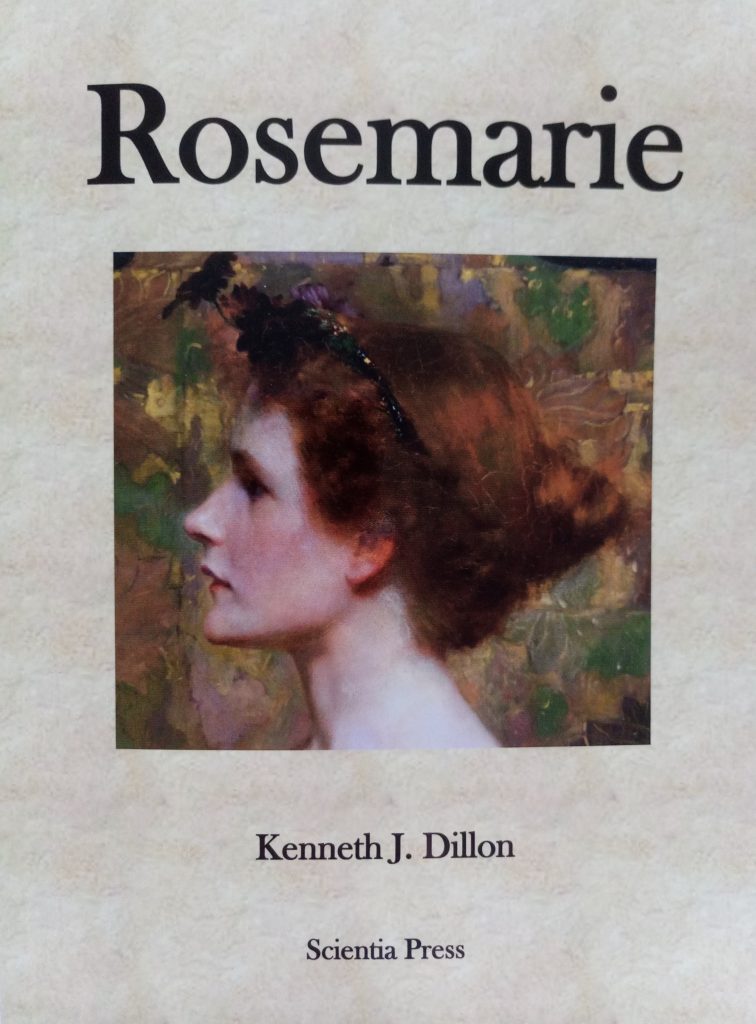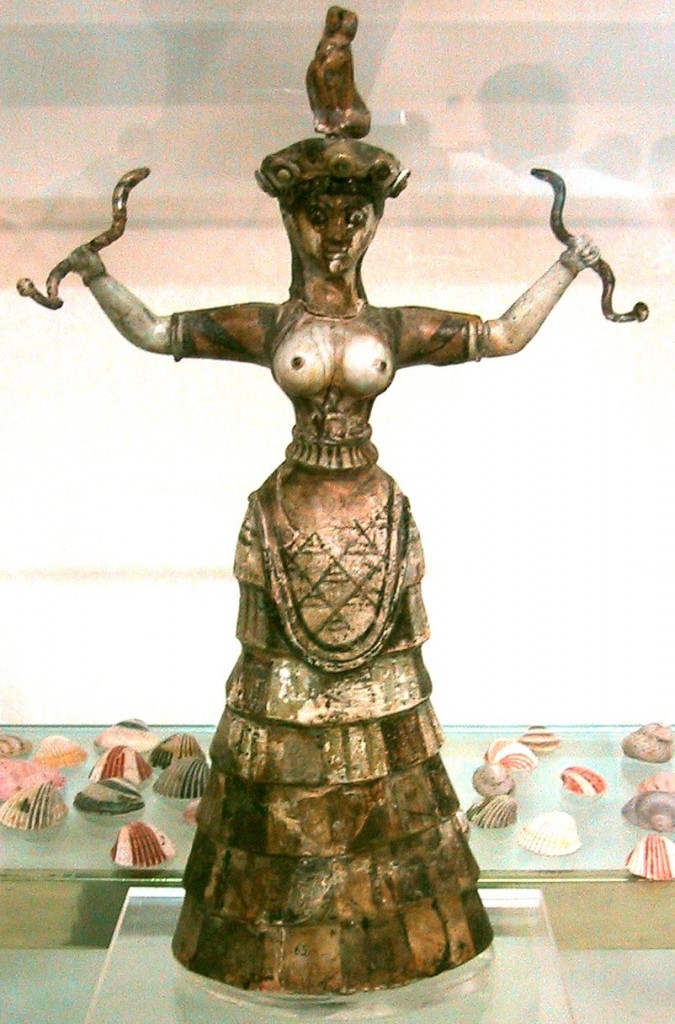 The famous Snake Goddess of ancient Crete has long attracted students of history and art. Elegant, risquée, enigmatic, she embodies the mystery and allure of Minoan civilization.
The famous Snake Goddess of ancient Crete has long attracted students of history and art. Elegant, risquée, enigmatic, she embodies the mystery and allure of Minoan civilization.
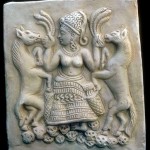 atterns in ancient civilization. In effect, calling her merely “Snake Goddess” might represent a Type 2 error, a failure to spot a significant pattern in the information available. A starting point: we can ask whether there is another image that resembles hers. In fact, at least one depiction of the leading Canaanite goddess Astarte shares striking features with the Snake Goddess. Both are topless, and both are holding snakes in their hands. At first glance, Astarte’s seem to be plants. But their snake eyes give them away. Then why does Astarte seem to be feeding them to the horses? And why are they cut off beneath her hands?
atterns in ancient civilization. In effect, calling her merely “Snake Goddess” might represent a Type 2 error, a failure to spot a significant pattern in the information available. A starting point: we can ask whether there is another image that resembles hers. In fact, at least one depiction of the leading Canaanite goddess Astarte shares striking features with the Snake Goddess. Both are topless, and both are holding snakes in their hands. At first glance, Astarte’s seem to be plants. But their snake eyes give them away. Then why does Astarte seem to be feeding them to the horses? And why are they cut off beneath her hands?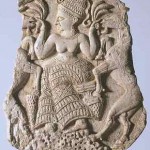 In a second depiction of Astarte, this time actually feeding plants to goats, may lie the answer. These plants no longer have snake eyes. The original story of a goddess with snakes in her hands could have made little sense to the artist of the first Astarte, who retained the snakes’ eyes but otherwise cut off their tails and introduced the horses in a feeding mode, one that was carried further in the second picture of Astarte, where the horses give way to goats and the half-snakes give way to 100% plants. In turn, this suggests that a conceivable original picture, of which we have no Canaanite instantiation, contains just Astarte holding full-length snakes, exactly as with the Cretan Snake Goddess.
In a second depiction of Astarte, this time actually feeding plants to goats, may lie the answer. These plants no longer have snake eyes. The original story of a goddess with snakes in her hands could have made little sense to the artist of the first Astarte, who retained the snakes’ eyes but otherwise cut off their tails and introduced the horses in a feeding mode, one that was carried further in the second picture of Astarte, where the horses give way to goats and the half-snakes give way to 100% plants. In turn, this suggests that a conceivable original picture, of which we have no Canaanite instantiation, contains just Astarte holding full-length snakes, exactly as with the Cretan Snake Goddess.Clearly, the artist who designed the Cretan figurine wanted to depict a goddess holding snakes, and that suggests that this depiction had meaning for him or her, or at least that it faithfully copied an image that had meaning for its creator. So, too, would a putative parallel original depiction of Astarte holding full-length snakes have held meaning for its Canaanite artist. What could that meaning have been?
Astarte was the goddess of the planet Venus—Ishtar in Mesopotamia and elsewhere, Isi (Isis) in Egypt, al-Uzza (the Sublime One) among the Arabs, by far the most important female deity of the ancient Near East. According to the theory of Immanuel Velikovsky (now in a Revised Venus Theory that corrects mistakes and adds new evidence), Ishtar/Astarte was the female version of the planet Venus, while the male version of Venus was the Bull of Heaven of the Gilgamesh epic and other sources. Interpreting evidence and myth, Velikovsky argued that at that time Venus was a comet with a tail that was divided into two prongs by the shadow cast by the comet/planet itself. Seeing the prongs as horns, the ancients called it the Bull of Heaven.(1) In Greece, its masculine name was Bos eidon (Poseidon), the bull of heaven.
Velikovsky also noted that “The Egyptian Venus-Isis, the Babylonian Venus-Ishtar, the Greek Venus-Athene were goddesses pictured with serpents, and sometimes represented as dragons.”(2) So it seems reasonable to think that the snakes in the hands of the Canaanite Astarte were the female parallel to the horns of the male Bull of Heaven. To the imaginative ancient observer, the divided tail of the comet/planet Venus resembled snakes held in the hands of the goddess. If this is correct, then it follows that the Cretan Snake Goddess was in all likelihood also Astarte, the goddess of the comet/planet Venus.
Why Topless?
An explanation of why the Cretan Snake Goddess is topless can be derived from a similar pattern of change from an original. While she preserves the naked breasts of her Canaanite counterpart, the Cretan lady wears a much more concealing and fashionable dress. Even her upper arms are covered. So it could be that the artist strove to preserve the identity of Astarte by retaining the naked breasts but otherwise sought to create a more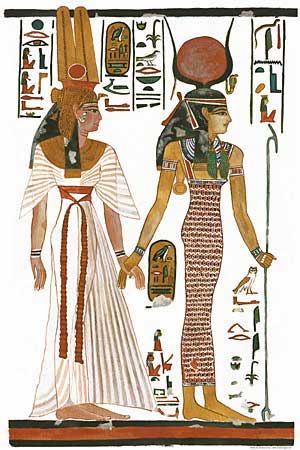 dignified and less provocative image of the goddess.
dignified and less provocative image of the goddess.
Some backing for this point might be extracted from an Egyptian depiction of Isis leading Nefertari, consort of Pharaoh Ramses II. While both figures are tastefully dressed, Isis seems at least somewhat topless. This could readily be explained as an attempt by the artist to remain true to a characteristic feature of Isis/Astarte while taking care not to offend Nefertari by anything as vulgar as a blatantly topless goddess. After all, this painting presumably refers to the entrance of Nefertari into the afterlife—a solemn, very personal religious occasion. The horns on the head of Isis and the reddish oval nested in them denote the comet Venus as well, with the redness caused by atmospheric and interplanetary smoke dust.
So the answer to “Why topless?” in the Cretan and Egyptian cases would seem to be: because Astarte/Isis ought to be depicted that way. In the Canaanite instance, in contrast, there is no hint of reserve or prudishness.
However, that still leaves unanswered the question of why the Canaanite Astarte should be topless. Endowing the new goddess Astarte with the age-old role of a fertility goddess would have effectively inserted her into the prevailing pantheon while ensuring that the critical function of fertility was performed by a major goddess. (The goddess was relatively new, presumably because the comet Venus had only shown up in the heavens shortly before 2500 BC, having emerged from Jupiter according to ancient myth, for which there is a commonsense explanation—Venus was pulled by Jupiter from the outer solar system, which seems also to have caused the molten Venus to become oval—and telling pictorial substantiation (3)). While Venus was destined for a long career as the goddess of love, the earliest sources on Astarte/Ishtar depict her rather as a terrifying goddess, and some peoples took Venus as their goddess of war.
A Simple Etymology
If the goddess was new because Venus was new, then we might also be able to identify the origin of the name Astarte or Ishtar, which has never been satisfactorily explained within Semitic linguistics (4). “What is the name of the new comet/planet?” people might well have asked. And the answer, derived from an Indo-European source, might then have been pronounced by them as Astarte or Ishtar because the word they heard was a variant of “star” (“setareh” in Persian). Sometimes language and history work in simple ways.
As for the Snake Goddess’s name, we can suppose that the Minoans called her The Phoenician, just as the Athenians would later call their Venus goddess Athena (=A Fena=The Phoenician) in reference to the brilliant Venus rising in the East.
So, if all this is correct, we now know the answers to Why topless? Why the snakes? as well as to two further questions: What were the Snake Goddess’s names, and where did those names come from? We also have an intriguing story of how original concepts and information become transformed over time by cultural amnesia and repurposing.
*****
Notes
(1) Immanuel Velikovsky. Worlds in Collision. New York: Dell, 1950, p. 175
(2) Ibid., p. 185
(3) Jupiter, Venus, and Velikovsky
(4) G. Johannes Botterweck, Helmer Ringgren, and Heinz-Josef Fabry, eds. Theological Dictionary of the Old Testament. Grand Rapids, Michigan: William B. Eerdmans Publishing Company, 1987-8, Vol. XI, pp. 423-34
*****
Kenneth J. Dillon is an historian who writes on science, medicine, and history. See the biosketch at About Us. The Revised Venus Theory figures in his novel Rosemarie. For further detective work in ancient and modern history, see his The Knowable Past (Second Edition, Washington, D.C.: Scientia Press, 2019).
